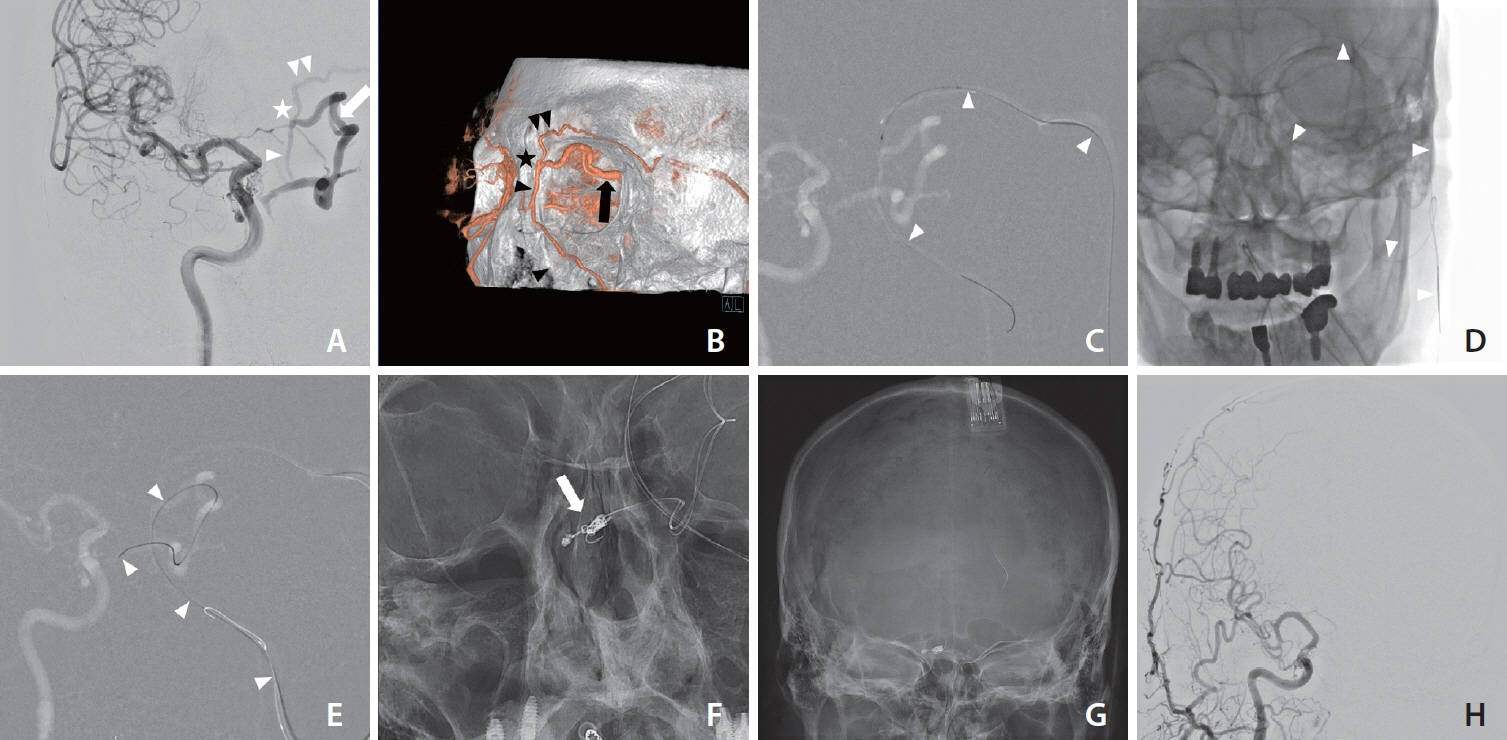Neurointervention.
2024 Mar;19(1):39-44. 10.5469/neuroint.2023.00493.
Facilitated Retrograde Access via the Facial Vein for Transvenous Embolization of the Cavernous Sinus Dural Arteriovenous Fistula with Isolated Ophthalmic Venous Drainage
- Affiliations
-
- 1Department of Radiology, College of Medicine, Majmaah University, Al Majmaah, Saudi Arabia
- 2Department of Radiology and Research Institute of Radiology, Asan Medical Center, University of Ulsan College of Medicine, Seoul, Korea
- KMID: 2552878
- DOI: http://doi.org/10.5469/neuroint.2023.00493
Abstract
- Management of cavernous sinus dural arteriovenous fistula (CSDAVF) continues to present significant challenges, particularly when the inferior petrosal sinus is thrombosed, collapsed, or angiographically invisible. In this study, we introduce facilitated retrograde access via the facial vein, which is employed in the transvenous embolization of CSDAVF with isolated superior ophthalmic venous drainage. We also present illustrative cases and technical points.
Figure
Reference
-
1. Hou K, Li G, Luan T, Xu K, Yu J. Endovascular treatment of the cavernous sinus dural arteriovenous fistula: current status and considerations. Int J Med Sci. 2020; 17:1121–1130.
Article2. Jia ZY, Song YS, Sheen JJ, Kim JG, Lee DH, Suh DC. Cannulation of occluded inferior petrosal sinuses for the transvenous embolization of cavernous sinus dural arteriovenous fistulas: usefulness of a frontier-wire probing technique. AJNR Am J Neuroradiol. 2018; 39:2301–2306.
Article3. Biondi A, Milea D, Cognard C, Ricciardi GK, Bonneville F, van Effenterre R. Cavernous sinus dural fistulae treated by transvenous approach through the facial vein: report of seven cases and review of the literature. AJNR Am J Neuroradiol. 2003; 24:1240–1246.4. Mounayer C, Piotin M, Spelle L, Moret J. Superior petrosal sinus catheterization for transvenous embolization of a dural carotid cavernous sinus fistula. AJNR Am J Neuroradiol. 2002; 23:1153–1155.5. Quinones D, Duckwiler G, Gobin PY, Goldberg RA, Vinuela F. Embolization of dural cavernous fistulas via superior ophthalmic vein approach. J Neuroophthalmol. 1999; 19:116.
Article6. Dye J, Duckwiler G, Gonzalez N, Kaneko N, Goldberg R, Rootman D, et al. Endovascular approaches to the cavernous sinus in the setting of dural arteriovenous fistula. Brain Sci. 2020; 10:554.
Article7. Bertha A, Suganthy R. Anatomical variations in termination of common facial vein. J Clin Diagn Res. 2011; 5:24–27.8. Cheung N, McNab AA. Venous anatomy of the orbit. Invest Ophthalmol Vis Sci. 2003; 44:988–995.
Article
- Full Text Links
- Actions
-
Cited
- CITED
-
- Close
- Share
- Similar articles
-
- Transvenous Embolization of Cavernous Sinus Dural Arteriovenous Fistula Using the Direct Superior Ophthalmic Vein Approach: A Case Report
- Middle temporal vein access for transvenous embolization of Cavernous sinus dural arteriovenous fistula: A case report and review of literature
- Transvenous Coil Embolization for Dural Arteriovenous Fistulas of the Ophthalmic Sheath: Report of Two Cases and Review of the Literature
- Transvenous Embolization of Dural Carotid Cavernous Fistula through the Supraorbital Vein
- Reversible Abducens Nerve Palsy Following Transvenous Embolization of Cavernous Sinus Dural Arteriovenous Fistula



